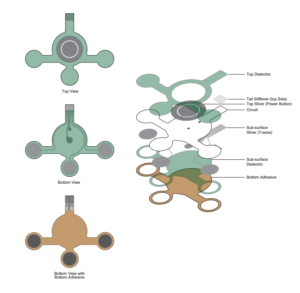 In the world of technology, we’re almost always trying to make parts that are smaller, more efficient, and less expensive to build. These endeavors touch almost every element of technological progress – and that includes biosensors.
In the world of technology, we’re almost always trying to make parts that are smaller, more efficient, and less expensive to build. These endeavors touch almost every element of technological progress – and that includes biosensors.
Biosensors have existed, in some form or another, for over a century. They’re used in all kinds of different industries, from healthcare to agriculture and food. Today, industries are readily experimenting with printed biosensors. In this article, we’re going to define what a biosensor is, then look at some of the implications of printed biosensors.
What are biosensors?
Biosensors are commonly associated with medical devices – a blood glucose meter, for example, is a classic example of a biosensor.
Realistically, however, the definition of biosensors is quite broad. Biosensors are comprised of:
- An analyte
- This is the substance the biosensor is detecting/monitoring. For a blood glucose meter, the analyte is glucose.
- A bioreceptor
- This is a substance that recognizes/reacts with the analyte in a measurable way. Glucose oxidase is a commonly used bioreceptor in blood glucose meters.
- A transducer
- This transforms the bioevent (reaction between analyte and bioreceptor) into something that can be measured in a meaningful way.
- Electronics
- They play many roles, from converting signals from analog to digital to amplifying signals. They also enable the use of some displays.
- Display
- The display shows the data gathered by the other four components to users. Displays should be user-friendly, and sometimes also act as user interfaces.
For a more comprehensive overview of biosensors, we recommend reading this introduction to biosensors.
The advantages of printed biosensors
Electronics are the most likely component of a biosensor to be printed, as printed circuits are already commonly used in several industries. Printed membranes with capacitive switches are a perfect example. When one or more components of a biosensor can be printed, there can be several advantages. These include:
- Disposable Parts
- Majority of biosensors are a disposable part with limited timeframe with some being only single use. Due to this, cost is a major driver when companies look for solutions and printed sensors on a thin profile polyester will drive the best low cost solution for companies.
- Printed biosensors on Thinner profiles
- Printed electronics tend to be thinner than their traditional counterparts. This is accomplished through the use of conductive inks, which are incredibly thin. Thinner profile electronics can make the biosensor more portable and can lead to more space for other components
- Lower shipping costs
- Because printed electronics are thinner, printed biosensors may weigh less, leading to lower shipping costs.
- Replicability
- These circuits are machine printed, which means they offer consistent functionality and results. When each printed circuit is individually tested (instead of batch tested), consistency and accuracy are further improved.
- Improved functionality
- As we’ll discuss in the next section, the future for printed biosensors is incredibly bright. There are innovative new uses for these sensors that have the potential to drastically shift how certain industries think about biosensors.
Potential applications for printed biosensor
Printed electronics are already commonly used in medical technology – almost every piece of consumer medical equipment has a membrane switch that combines industrial graphics with a user interface that interacts with a printed circuit. That means OEMs already trust switch manufacturers to create printed electronics in contaminant-free clean rooms.
That means the infrastructure for printed biosensors is already in place. What might these printed biosensors look like? There are a couple of promising examples.
The first are biosensors that are printed and placed directly on the skin. These biosensors are easily removed, and could potentially monitor a wide variety of different biometrics, from heart rate to hydration. They may also help increase accuracy, as close contact with the skin is vital for sensor performance.
Another potential application for printed biosensors can be found in the food industry. Rapid detection and elimination of bacteria are essential to prevent food-borne illness. In the best-case scenario, the technologies enabling this should be low-cost and portable, to ensure that they can be readily accessed by countries with less wealth. Promising work has been done on such a sensor – an all-printed biosensor that detects bacteria.
The future of printed biosensors looks bright
As more use cases for printed biosensors are found, more novel technology will be developed. That, in turn, will increase demand for these printed biosensors, which should spur more manufacturing and innovation. Practically, this should lower the cost of printed biosensors, which should lower the barrier of entry for new technologies to be developed.
What we’ve just described is a virtuous cycle – technology and innovation breeding technology and innovation, all with the goal of improving people’s lives. That’s something that General Label excited about – the future of printed electronics is bright.